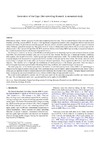Identificador persistente para citar o vincular este elemento:
https://accedacris.ulpgc.es/jspui/handle/10553/7918
| Título: | Generation of the Cape Ghir upwelling filament: a numerical study | Autores/as: | Troupin, Ch. Mason, Evan Beckers, Jean Marie Sangrá Inciarte, Pablo |
Clasificación UNESCO: | 251007 Oceanografía física | Palabras clave: | Eastern boundary Canary upwelling system Upwelling filaments Potential vorticity ROMS model |
Fecha de publicación: | 2012 | Publicación seriada: | Ocean Modelling | Resumen: | Filaments are narrow, shallow structures of cool water originating from the coast. They are typical features of the four main eastern boundary upwelling systems (EBUS). In spite of their significant biological and chemical roles, through the offshore exportation of nutrient-rich waters, the physical processes that generate them are still not completely understood. This paper is a process-oriented study of filament generation mechanisms. Our goal is twofold: firstly, to obtain a numerical solution able to well represent the characteristics of the filament off Cape Ghir (30°38'N, northwestern Africa) in the Canary EBUS and secondly, to explain its formation by a simple mechanism based on the balance of potential vorticity.\n\nThe first goal is achieved by the use of the ROMS model (Regional Ocean Modeling System) in embedded domains around Cape Ghir, with a horizontal resolution going up to 1.5 km for the finest domain. The latter gets its initial and boundary conditions from a parent solution and is forced by climatological, high-resolution atmospheric fields. The modeled filaments display spatial, temporal and physical characteristics in agreement with the available in situ and satellite observations. This model solution is used as a reference to compare the results with a set of process-oriented experiments. These experiments allow us to reach the second objective. Their respective solution serves to highlight the contribution of various processes in the filament generation. Since the study is focused on general processes present under climatological forcing conditions, inter-annual forcing is not necessary.\n\nThe underlying idea for the filament generation is the balance of potential vorticity in the Canary EBUS: the upwelling jet is characterized by negative relative vorticity and flows southward along a narrow band of uniform potential vorticity. In the vicinity of the cape, an injection of relative vorticity induced by the wind breaks the existing vorticity balance. The upwelling jet is prevented from continuing its way southward and has to turn offshore to follow lines of equal potential vorticity.\n\nThe model results highlight the essential role of wind, associated with the particular topography (coastline and bottom) around the cape. The mechanism presented here is general and thus can be applied to other EBUS. | URI: | https://accedacris.ulpgc.es/handle/10553/7918 | ISSN: | 1463-5003 | DOI: | 10.1016/j.ocemod.2011.09.001 | Fuente: | Ocean Modelling, [ISSN 1463-5003], v. 41, p.1-15 | Derechos: | by-nc-nd |
| Colección: | Artículos |
Citas SCOPUSTM
20
actualizado el 08-jun-2025
Citas de WEB OF SCIENCETM
Citations
22
actualizado el 08-jun-2025
Visitas
62
actualizado el 23-sep-2023
Descargas
128
actualizado el 23-sep-2023
Google ScholarTM
Verifica
Altmetric
Comparte
Exporta metadatos
Los elementos en ULPGC accedaCRIS están protegidos por derechos de autor con todos los derechos reservados, a menos que se indique lo contrario.
